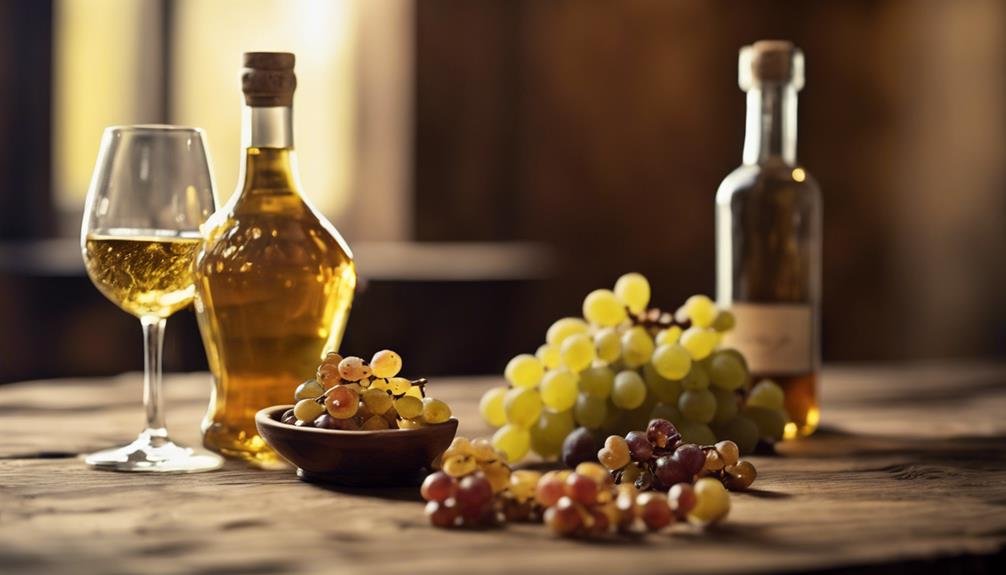Italian Vin Santo is a renowned sweet dessert wine originating from Italy. It boasts a full-bodied nature with diverse aromas and colors, traditionally enjoyed with Cantucci biscuits for a delightful contrast. This wine's aging potential is impressive, intensifying its flavors over time. Vin Santo pairs well with a variety of desserts, from fruit tarts to panna cotta. The production process involves grape drying, natural fermentation in special barrels, and aging to develop unique flavors. Variations exist in sweetness and alcohol content among different producers, contributing to the wine's diverse profiles. Vin Santo is a cherished indulgence with a rich history that captivates wine enthusiasts worldwide.
Vin Santo: A Sweet Dessert Wine
Vin Santo, a renowned sweet dessert wine originating from Italy, is characterized by its full-bodied nature, varied aromas, and a color palette ranging from pale gold to deep auburn brown.
When it comes to food pairings, Vin Santo is traditionally served with Cantucci, a type of almond biscuit, creating a delightful contrast between the wine's sweetness and the biscuit's crunchiness. This wine also complements a wide range of desserts, from fruit tarts to creamy panna cotta.
Vin Santo boasts impressive aging potential, with some bottles improving in flavor over decades. The aging process enhances its complexity, allowing flavors to develop and intensify, making it a perfect choice for those seeking a well-rounded and mature dessert wine experience.
The History and Origin of Vin Santo
The rich history and origins of the revered Italian sweet dessert wine, Vin Santo, trace back to ancient winemaking traditions in the picturesque region of Tuscany.
The name 'Vin Santo' is believed to have connections to Easter, as the fermentation process traditionally begins around that time. Some theories suggest that the name 'Holy Wine' may have stemmed from this Easter connection.
This sweet wine has been cherished for centuries, with its production steeped in tradition and symbolism. Vin Santo's deep-rooted history and associations with religious events contribute to its cultural significance and allure.
The blend of tradition, craftsmanship, and a touch of mystique makes Vin Santo a truly unique and cherished wine among enthusiasts worldwide.
Vin Santo Production Process Explained

The intricacies of crafting Vin Santo unfold in a meticulous process that encapsulates centuries-old traditions intertwined with the essence of time-honored winemaking practices. To produce this revered sweet wine, the following steps are essential:
- Grape Drying: Grapes undergo a drying process known as passito before being pressed.
- Fermentation Techniques: The raisins are placed in special barrels called Caratelli for natural fermentation, a slow process that can last up to 4 years.
- Barrel Aging: After fermentation, Vin Santo is aged in barrels, allowing it to develop its unique flavors and aromas.
- Variability: Different producers yield varying levels of sweetness and alcohol content, contributing to the diverse profiles of Vin Santo wines available in the market.
Grape Varieties Used in Vin Santo
Among the array of grape varieties employed in crafting Italian Vin Santo, a notable diversity emerges in the selection of traditional and indigenous grapes. In Tuscany, a blend of Trebbiano and Malvasia is commonly used, producing the classic sweet profile of Vin Santo. For the red variation, Sangiovese and Malvasia Nera are the preferred grape varietals.
Moving to Veneto, Garganega grapes are utilized, while Nosiola grapes are prominent in Trentino's Vin Santo. Marche stands out with unique grapes like Passerina contributing to its Vin Santo production. Understanding these grape varietals is essential for appreciating the distinct flavors and characteristics of Vin Santo, enhancing Vin Santo pairings and overall wine enjoyment.
Exploring Alternative Passito Wines

Explore a diverse spectrum of Italian wines crafted using the passito method to uncover unique flavors and regional specialties.
- Marche Passito Wines: Discover the richness of Verdicchio dei Castelli de Jesi Passito and the invigorating qualities of Lacrima di Morro d'Alba Passito.
- Lombardy Passito Wines: Indulge in the sweetness of Valcelepio Moscato Passito and the elegance of Lugana Moscato Passito.
- Piedmont and Aosta Valley Passito Wines: Delight in the fruity notes of Piemonte Moscato Passito and the invigorating Valle d'Aosta Moscato Passito.
- Sicily and Sardinia Passito Wines: Experience the exotic flavors of passito wines from these regions, each showcasing unique grape varietals.
Frequently Asked Questions
What Are the Best Food Pairings for Vin Santo?
When considering food pairings for Vin Santo, ideal options include dessert choices like cantucci or biscotti, cheese selections such as aged pecorino or gorgonzola, and savory dishes that balance the wine's sweetness, making it suitable for wine tastings.
How Should Vin Santo Be Stored Once Opened?
Proper storage of Vin Santo once opened is essential for preserving its delicate flavors. Seal tightly and store in a cool, dark place. To enjoy, serve slightly chilled at around 55°F to enhance its aromas and balance.
Can Vin Santo Be Used in Cooking or Baking?
Vin Santo desserts can be enhanced by using this sweet wine in recipes like tiramisu or fruit salads. Vin Santo marinades can elevate the flavors of meats like pork or poultry. Its rich sweetness adds depth to a variety of dishes.
Are There Specific Glasses Recommended for Serving Vin Santo?
When serving Vin Santo, opt for small tulip-shaped glasses to concentrate its aromas. To savor this sweet wine, swirl gently to release notes of dried fruits and nuts. Enjoy its richness and complexity sip by sip.
How Can One Distinguish Between High-Quality and Low-Quality Vin Santo Wines?
To distinguish high-quality Vin Santo wines, consider flavor complexity, balance, and longevity. Evaluate aging process, vineyard regions like Tuscany, Veneto, and Trentino, and traditional production techniques. Look for nuanced aromas, rich texture, and well-integrated sweetness.
Conclusion
To sum up, Italian Vin Santo stands as a cherished tradition with its unique production methods and rich history. The irony lies in its sweetness, which may surprise those accustomed to drier wines.
Despite its reputation as a dessert wine, Vin Santo's complexity and depth make it a versatile option for any occasion. With a nod to tradition and a sip of this luscious wine, one can truly savor the flavors of Italy's vinicultural heritage.
Cheers to Vin Santo!
